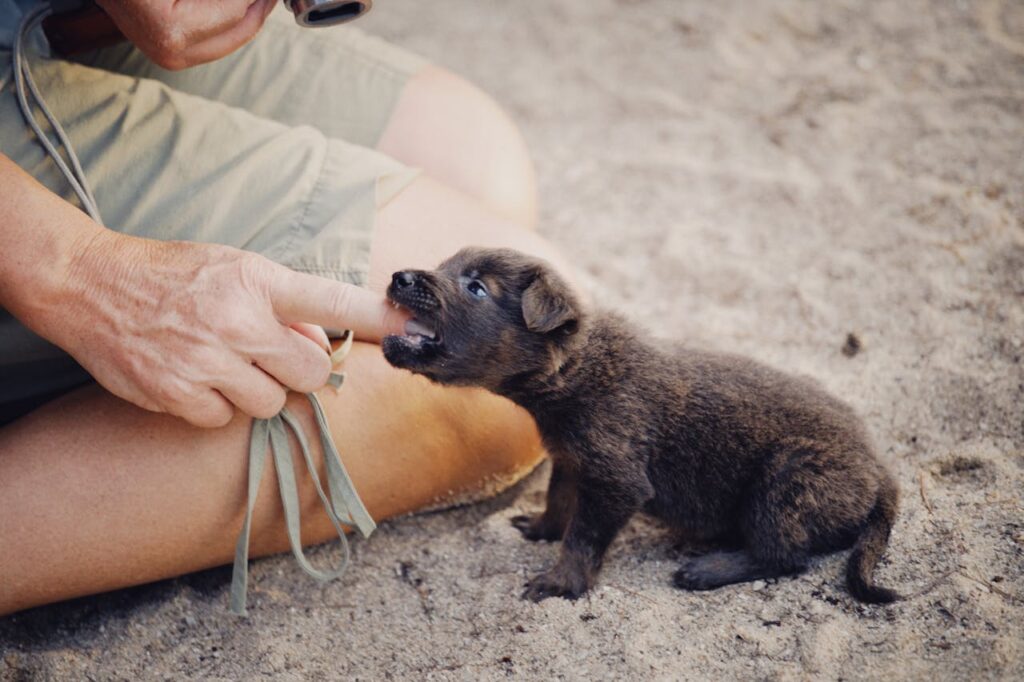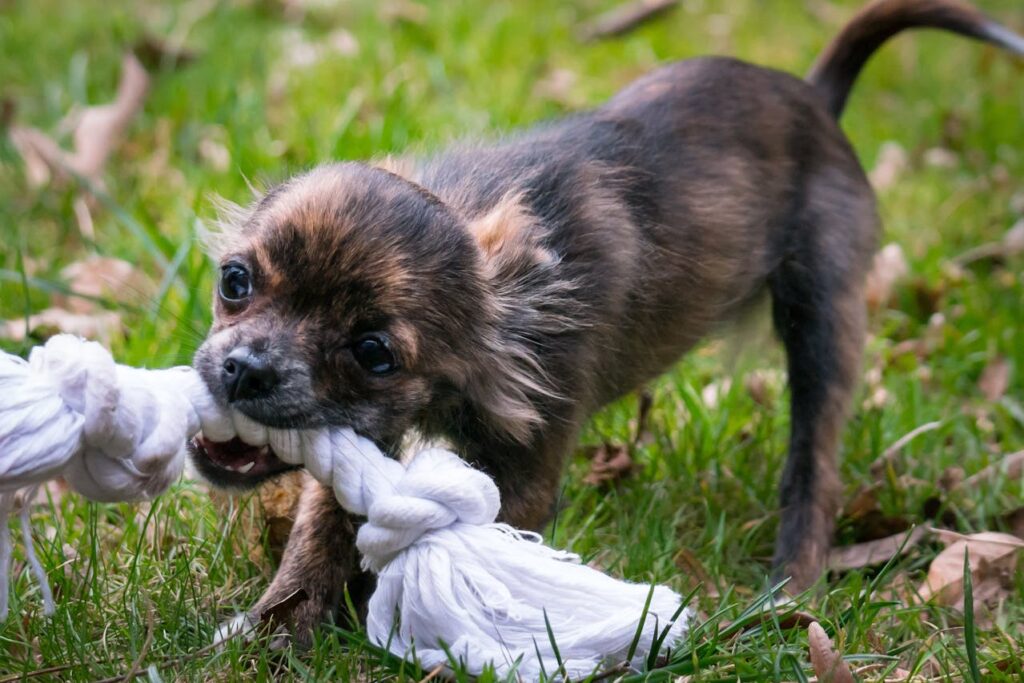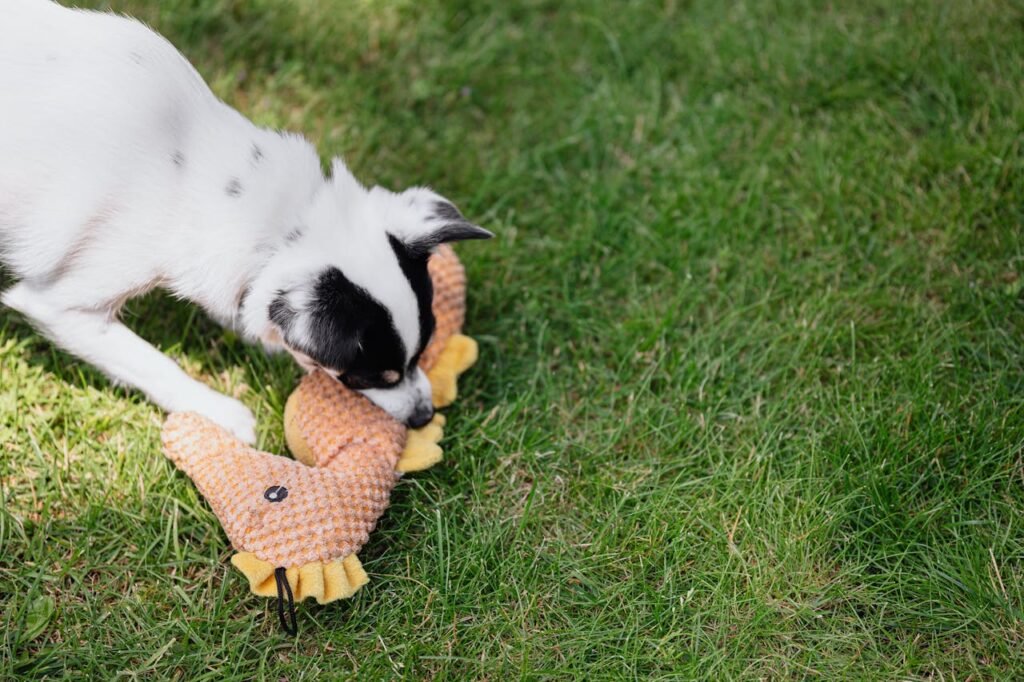Welcoming a Pitbull puppy into your home can be an incredibly rewarding experience. They’re playful, loving, and full of energy.
However, as a new Pitbull puppy parent, you might find yourself dealing with a common challenge: biting.
Puppies, particularly Pitbulls, are naturally curious, and they often explore their world using their mouths.
While this is completely normal, it can be frustrating when your puppy’s biting behavior turns into a problem.
If you’re wondering how to train a Pitbull puppy not to bite, you’re in the right place. This guide will provide you with all the tips you need to curb this behavior and guide your puppy toward being a polite and well-behaved companion.
1. Introduce Appropriate Chew Toys Early On
When you want to learn how to train a Pitbull puppy not to bite, it’s crucial to provide them with the right chew toys from the start.
Pitbull puppies, like all dogs, need to chew, especially when they’re teething. It’s essential to give them the right tools to express this natural behavior. Rubber bones, teething rings, and plush toys are great options.
If your Pitbull tries to chew on your belongings, calmly redirect them by offering one of their toys. Whenever they chew on the right item, give them praise and treats to reinforce the behavior.
This helps establish the habit early on, making it easier for them to understand how to train a Pitbull puppy not to bite in the future.

2. Avoid Harsh Punishment: Stay Calm
One of the most important things you need to remember when learning how to train a Pitbull puppy not to bite is to avoid harsh punishment.
Hitting, yelling, or any form of aggression can confuse your puppy and cause fear-based issues. Instead, focus on calmly redirecting their behavior.
If you catch your puppy in the act of chewing something inappropriate, gently remove the item from their mouth and replace it with a chew toy.
Avoid shouting or getting physical with them, as this can cause anxiety. Positive reinforcement will help more in teaching your puppy appropriate behavior, which is a key part of how to train a Pitbull puppy not to bite.
3. Reward Good Behavior to Encourage Learning
To effectively learn how to train a Pitbull puppy not to bite, it’s important to use positive reinforcement. Rather than focusing solely on punishing unwanted behavior, reward your puppy when they make the right choices.
For example, when they chew on an appropriate toy instead of your shoes, praise them with a happy voice and offer a treat.
Positive reinforcement strengthens the connection between chewing on the right items and receiving rewards, which makes it more likely your puppy will repeat this behavior in the future.

4. Ensure Your Puppy Gets Plenty of Exercise
Pitbull puppies are incredibly energetic, and if they don’t get enough physical activity, they can quickly become bored and resort to undesirable behaviors like chewing and biting.
If you’re struggling with how to train a Pitbull puppy not to bite, make sure your puppy gets plenty of exercise. Daily walks, play sessions, and interactive games are great ways to burn off excess energy.
Additionally, mental stimulation through puzzle toys and short “sniff” walks can keep your puppy engaged. The more satisfied your puppy is physically and mentally, the less likely they are to engage in biting.
5. Use Taste Deterrents for Unwanted Chewing
Sometimes, despite your best efforts, your puppy may still try to chew on something they shouldn’t. If that happens, a taste deterrent can be a useful tool to discourage them.
These sprays are designed to taste bitter or unpleasant, which can make your puppy associate chewing on the wrong items with an undesirable experience.
When trying to learn how to train a Pitbull puppy not to bite, using a taste deterrent on furniture or shoes can be effective in preventing chewing on those items.
Just be aware that some puppies may be more persistent, so you may need to combine this strategy with others, like redirection and positive reinforcement.

6. Avoid Reinforcing Negative Attention-Seeking Biting
Pitbull puppies are smart and will often use biting as a way to get your attention. If you’re struggling with how to train a Pitbull puppy not to bite, it’s essential not to reinforce this behavior.
Yelling or scolding can excite your puppy and make them more likely to continue biting for attention. Instead, when your puppy bites to get your attention, simply ignore them.
Turn your back and avoid eye contact. If they continue, calmly leave the room for a few minutes. When you return, give them attention and affection only when they are calm.
This teaches your puppy that calm behavior, not biting, gets the attention they seek.
7. Be Consistent with Your Training
When learning how to train a Pitbull puppy not to bite, consistency is key. Dogs thrive on routines and clear boundaries, so it’s crucial to be consistent with your training.
If one day you allow your puppy to chew on your shoes and the next day you don’t, it will confuse them. Establish clear rules about what your puppy can and cannot chew on, and stick to them.
Consistency in training helps your puppy understand what is expected, making it easier for them to learn how to behave appropriately.

8. Seek Professional Training If Necessary
Training a Pitbull puppy can be challenging, especially for first-time dog owners. If you’re struggling with how to train a Pitbull puppy not to bite despite your best efforts, it might be time to seek professional help.
Puppy training classes or one-on-one sessions with a professional trainer can provide personalized advice and techniques.
A professional trainer can help you understand your puppy’s behavior better, and they can teach you how to address biting and other behavioral problems more effectively.

Final Thoughts
Training your Pitbull puppy not to bite requires time, patience, and consistency. By offering appropriate chew toys, avoiding harsh punishment, rewarding good behavior, ensuring enough exercise, and using deterrents when necessary, you can guide your puppy toward better habits.
The key to success when learning how to train a Pitbull puppy not to bite lies in positive reinforcement.
Stay consistent, and with time, your puppy will learn how to use their mouth appropriately and become the well-behaved companion you’ve always wanted. Happy training!
See also:
What Is Chicken By-Product in Dog Food?
How Long Can Dogs Be in the Rain?

